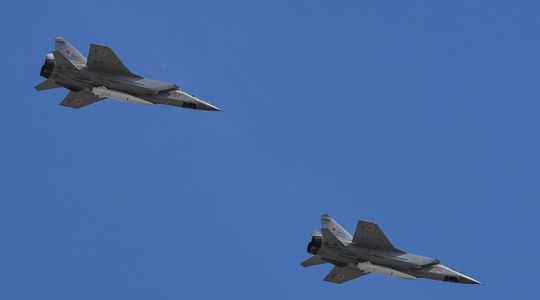It is a manoeuvrable weapon, moving at speeds over 6000 kilometers per hour, five times the speed of sound. Some can potentially go up to 25,000 kilometers per hour. The hypersonic missile would now be manufactured by Iran. Tehran has indeed claimed this Thursday, November 10 to have manufactured a missile capable of “crossing all missile defense systems”.
“This hypersonic ballistic missile can counter air defense shields,” said General Amirali Hajizadeh, the commander of the Aerospace Force of the Revolutionary Guards, Iran’s ideological army. “It will be able to pass through all anti-missile defense systems and I do not think there will be a technology to deal with it for decades,” he said, quoted by the Fars agency.
Unlike ballistic missiles, hypersonic missiles fly at low altitude in the atmosphere and are manoeuvrable, which makes their trajectory difficult to predict and their interception difficult. According to Colonel of the Air and Space Force David Pappalardo, interviewed by AFP, the weapon allows in particular “to adopt a flight profile less exposed to current detection and interception systems, to stun the adversary” and to make the trajectories unpredictable. Hypersonic cruise missiles travel through the atmosphere like conventional missiles, but much faster. Hypersonic gliders, on the other hand, are launched aboard a ballistic missile and then released to enter the upper atmosphere and glide towards their target.
Russia’s head start
These hypersonic missiles revive fears of a new arms race. Moscow took a head start, announcing in March 2022 that it had used Kinjal (“dagger” in Russian) hypersonic missiles in Ukraine, a few weeks after the start of the invasion on February 24, but also the Zircon, that it announced in October 2021 that it had successfully tested from a submarine, or even the Avangard glider.
Russia announced on August 18 that it had deployed planes equipped with state-of-the-art hypersonic missiles in Kaliningrad, in a context of strong tensions around this Russian enclave surrounded by NATO countries, in the midst of conflict in Ukraine. Three MiG-31s with hypersonic Kinjal missiles have been redeployed to the Chkalovsk airfield in the Kaliningrad region,” the Russian Defense Ministry said in a statement. The three aircraft will form a combat unit “operational 24 hours a day. 24”, he added. The “Kinjal” hypersonic ballistic missiles and the “Zircon” cruise missiles belong to a family of new weapons developed by Russia and which its President, Vladimir Putin, calls “invincible”. “, because supposed to be able to escape the opposing defense systems.
The United States does not yet have hypersonic missiles but is working on them. The Darpa, scientific arm of the American army, affirmed shortly after the Russian announcement to have successfully tested its hypersonic missile HAWC, which uses the oxygen present in the atmosphere for its combustion. The Pentagon is also developing a hypersonic glider called ARRW, but its first full-scale test failed. China has several projects close to Russian programs, according to a study by the US Congressional Research Center. She tested a glider with a range of 2000 kilometers capable of performing “extreme maneuvers”.
After three tests (one in September 2021 and two in January 2022), North Korea for its part claimed to have successfully completed the tests of its first hypersonic glider missile. In addition, France, Germany, Australia, India, Japan, Israel and South Korea, in particular, are seeking to develop systems.
Rocket capable of carrying satellites into space tested “successfully”
The Iranian announcement comes as Westerners have been trying for more than a year to revive the 2015 nuclear deal between the major powers and Tehran. The Director General of the International Atomic Energy Agency (IAEA), Rafael Grossi, said the announcement “reinforced concerns” about Iran’s nuclear program. “The core of our work is nuclear, but of course nothing can be taken in isolation. We see all these announcements which heighten concerns, heighten public attention regarding Iran’s nuclear program,” Rafael Grossi told AFP. AFP, during an interview on the sidelines of COP27 in Sharm el-Sheikh, Egypt. He added, however, that this announcement “should not have any influence” on negotiations around Iran’s nuclear program.
This agreement aimed at preventing Iran from acquiring atomic weapons in exchange for the lifting of international sanctions has been in disrepair since the unilateral withdrawal in 2018 of the United States under the presidency of Donald Trump, which led to the progressive release by Tehran of its obligations. Negotiations, already deadlocked, now seem impossible.
On November 5, Iran also announced that it had “successfully” tested a rocket capable of carrying satellites into space. Western governments fear that satellite launch systems will incorporate technologies interchangeable with those used in ballistic missiles capable of delivering a nuclear warhead, something Iran has always denied wanting to build. Tehran insists its space program is for civilian and defense purposes only, and does not violate the 2015 agreement or any other international agreement.
Iran, shaken for almost two months by demonstrations triggered by the death on September 16 of Mahsa Amini, a young Iranian Kurd arrested by the morality police, accuses its “enemies”, in particular the United States, of wanting destabilize the country. This Wednesday, Tehran warned the countries of the region, in particular Saudi Arabia, that it would retaliate to any action of destabilization targeting the Islamic Republic.
